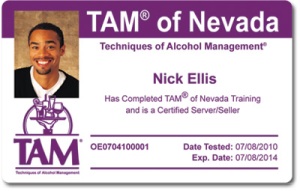 Bartenders and servers have a tough job. They must juggle customer satisfaction and safety with fast-paced service, heavy lifting, and hot kitchens… and do it all with smiles on their faces. Given the rigors of the job, a great hospitality worker can be a rare and welcome find.
Bartenders and servers have a tough job. They must juggle customer satisfaction and safety with fast-paced service, heavy lifting, and hot kitchens… and do it all with smiles on their faces. Given the rigors of the job, a great hospitality worker can be a rare and welcome find.
What can one do to make sure they are putting their best foot forward? Robert Plotkin of Nightclub & Bar Magazine laid out some of the cardinal rules of superior bar service in his recent article, “The 10 Commandments of Excellent Service.” We here at TAM of Nevada agree with all of these points on what makes for excellent bar service. Like we stated in our blog post, “Set the Tone and Increase Your Earnings with Positive Body Language,” making an excellent martini will only get you so far. A positive attitude, an ability to multitask, and friendly, welcoming attitude are all must-have qualities in a top-notch hospitality professional. You can read the full article here, and here are a couple more tips that we’d add to the list:
- Know the menu. Familiarize yourself with both your regular menu, as well as any specials for the day, happy hour deals, etc. Guests with dietary restrictions may have questions about ingredients or preparation, and if you can correctly and quickly answer those questions without heading to the kitchen to confer with the chef, all the better. Guests will also appreciate your tips and suggestions on what’s best if they’re deciding between a few options.
- Check in on your guests, and listen to their feedback. Dropping off a drink or meal and disappearing only to return once they’ve finished is bad form. Check back to make sure your guests are happy, and when you ask, “How’s everything?” listen to the answer. If something isn’t right, do what you can to fix it.
Hiring managers at bars, casinos and restaurants are looking for well-rounded staff members who are willing to go the extra mile to ensure guest satisfaction. Making small changes to your routine to make sure you’re treating each guest like they are appreciated and welcome is the first step toward becoming a first-rate team member in the eyes of your manager. What insider tips would you give someone looking to excel the in hospitality industry?
Resources
The 10 Commandments of Excellent Service – Nightclub & Bar
© 2011 National Hospitality Institute®, TAM® of Nevada

 The ban on caffeinated alcoholic beverages, also called alcopop, was one of the biggest stories in the beverage service and sales industry in 2010. Popular beverages such as Four Loko were called dangerous, a binge in a can, and worse. Last November the Food and Drug Administration declared alcoholic energy drinks to be a public health concern. The FDA concluded that caffeine added to malt alcoholic beverages was an unsafe food additive (
The ban on caffeinated alcoholic beverages, also called alcopop, was one of the biggest stories in the beverage service and sales industry in 2010. Popular beverages such as Four Loko were called dangerous, a binge in a can, and worse. Last November the Food and Drug Administration declared alcoholic energy drinks to be a public health concern. The FDA concluded that caffeine added to malt alcoholic beverages was an unsafe food additive ( A recent news story regarding the accidental service of an alcoholic beverage to a minor is making waves, and it serves to remind us exactly why alcohol awareness education is so important. A toddler was recently served an alcohol-infused margarita mix in place of apple juice at an Applebee’s restaurant in Michigan, possibly the result of a mislabeled bottle at the bar. You can read the full story on The Detroit News’ website
A recent news story regarding the accidental service of an alcoholic beverage to a minor is making waves, and it serves to remind us exactly why alcohol awareness education is so important. A toddler was recently served an alcohol-infused margarita mix in place of apple juice at an Applebee’s restaurant in Michigan, possibly the result of a mislabeled bottle at the bar. You can read the full story on The Detroit News’ website  Often imitated, never duplicated, TAM® of Nevada has been the sole provider of official TAM® Cards to the Las Vegas community for over 25 years. There are several providers of credible and effective alcohol awareness training and drink cards, but TAM® of Nevada is the only authorized provider of the official TAM® card. Also, more employers recommend TAM® of Nevada for their employees’ alcohol education than any other provider. Wonder why? You can learn more about what sets TAM® of Nevada apart and makes our training unique
Often imitated, never duplicated, TAM® of Nevada has been the sole provider of official TAM® Cards to the Las Vegas community for over 25 years. There are several providers of credible and effective alcohol awareness training and drink cards, but TAM® of Nevada is the only authorized provider of the official TAM® card. Also, more employers recommend TAM® of Nevada for their employees’ alcohol education than any other provider. Wonder why? You can learn more about what sets TAM® of Nevada apart and makes our training unique